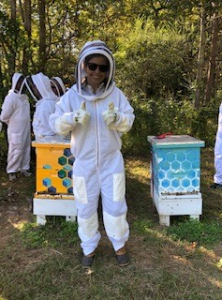Sometimes, during my day-to-day job, I get to experience some really fun and unique things. I’m thankful that  these experiences, while work-related, sometimes spark deeper reflection about the world around me. Case in point: a few weeks ago, I zipped into a bee suit to tour and learn about SAS’ beehives and left the experience with a renewed perspective on sustainability and teamwork.
these experiences, while work-related, sometimes spark deeper reflection about the world around me. Case in point: a few weeks ago, I zipped into a bee suit to tour and learn about SAS’ beehives and left the experience with a renewed perspective on sustainability and teamwork.
Wait. Hold up. Beehives? At a software company?
 Yup, you read that right! We’ve got honey bees! About 125,000 of them, actually.
Yup, you read that right! We’ve got honey bees! About 125,000 of them, actually.
Since 2017, SAS has partnered with Bee Downtown to host 4 beehives at our Cary, NC Headquarters. Bee Downtown is a North Carolina startup that is committed to building healthy honey bee populations, and they do so in an unconventional way: placing hives on corporate campuses. Businesses both large and small “sponsor” honey bee hives that are maintained by the knowledgeable Bee Downtown team. The Bee Downtown team loves getting employees involved, and occasionally offers tours to teach employees about the importance of honey bee sustainability and the ins-and-outs of their care. Sign. Me. Up.
The Tour
 Ok, back to the bees. Our tour started out with our awesome guides, Ben and Scottie, giving us a quick lesson in bee safety. Turns out the adage is true – if you don’t bother bees, they (generally) won’t bother you. We suited up, pulled on gloves, and then headed out to SAS’ hives to *mingle* with the bees.
Ok, back to the bees. Our tour started out with our awesome guides, Ben and Scottie, giving us a quick lesson in bee safety. Turns out the adage is true – if you don’t bother bees, they (generally) won’t bother you. We suited up, pulled on gloves, and then headed out to SAS’ hives to *mingle* with the bees.
Ben and Scottie opened the hives one by one, passing around hive frames covered with bees. As the bees flew around us, Ben and Scottie shared their vast knowledge of honey bee keeping with us. Did you know that bees sometimes hold hands (called “Festooning”)? I didn’t, but it sure is cute!
While the bees are super cute, we really do need these little pollinators. During the tour, I picked up a few honeybee fast facts:
- Honey bees are responsible for every third bite of food that we consume.
- Honey bees are dying at an alarming rate – in 2016 the U.S. alone lost over 44% of its honey bees.
- Honey bees rarely sting – and when they do, it’s usually only to protect their hives.
As I watched the bees work, I was struck with how incredibly focused and collaborative they were - each bee did a tiny job, yet together they had created a beautiful (and functional) network of honeycomb. As we passed around the honeycomb, the bees hardly seemed to notice, but I looked on with a fresh, new perspective of how important their work is.
A Sustainability Lesson From Bees
 The bees’ coordination reminded me of the importance of the “big picture” of sustainability. It’s easy to feel like our individual choices don’t matter – recycling paper, using reusable water bottles, and other everyday choices that can seem minute in the moment. These choices are small in scale but add up to create big change – just like how the hundreds of thousands of bees’ work culminates in pounds of honey and an intricate network of comb.
The bees’ coordination reminded me of the importance of the “big picture” of sustainability. It’s easy to feel like our individual choices don’t matter – recycling paper, using reusable water bottles, and other everyday choices that can seem minute in the moment. These choices are small in scale but add up to create big change – just like how the hundreds of thousands of bees’ work culminates in pounds of honey and an intricate network of comb.
Getting to interact with SAS’ bees was an experience I won’t soon forget – and I hope that the bees can inspire our communities and corporations to invest in the future through sustainability. I’m thankful to work for a company that cares - one that inspires me to live a more sustainable life and leads by example.
Curious about SAS’ commitment to sustainability? Check out our Corporate Social Responsibility report detailing all things green. There’s a lot going on! My personal favorite (other than the bees, of course)? The solar farm, and its grass-munching Dorper sheep!
And if you’re interested in helping out the honey bees – check out these 8 Practical Things You Can Do to Help Save the Bees.

3 Comments
I'm also interested and I need more information
Nice blog keep going on posting
Please write more articles on this topic